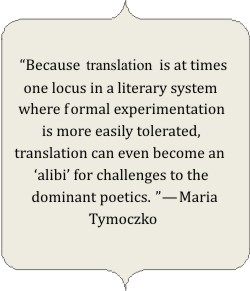Innovation and Experimentation
Translations can also affect literary forms as they afford scope for literary experimentation in the target language. A poem like Eliot's The Wasteland is a case in point.  It was a bold innovation in English literature; a Malayalam translation would have to reproduce its innovative structural and thematic patterns, thus introducing a new poetic sensibility. This is a way to introduce a new literary technique to the receptor culture. Postcolonial literature likewise brings native literary techniques to the attention of an international audience. Tymoczko again cites Ngugi as an example. The writer can synthesize aspects of his/her culture with a dominant culture to produce vibrant literary works, just as a translator can come up with new literary techniques for the receptor culture. Either way this is a broadening of literary horizons as far as the receptor culture is concerned. Translation also impacts the source culture though this is an aspect that most critics do not think of. The multiple versions of Shakespeare, for example, are an indication of the richly layered complexity of the great artist. It was a bold innovation in English literature; a Malayalam translation would have to reproduce its innovative structural and thematic patterns, thus introducing a new poetic sensibility. This is a way to introduce a new literary technique to the receptor culture. Postcolonial literature likewise brings native literary techniques to the attention of an international audience. Tymoczko again cites Ngugi as an example. The writer can synthesize aspects of his/her culture with a dominant culture to produce vibrant literary works, just as a translator can come up with new literary techniques for the receptor culture. Either way this is a broadening of literary horizons as far as the receptor culture is concerned. Translation also impacts the source culture though this is an aspect that most critics do not think of. The multiple versions of Shakespeare, for example, are an indication of the richly layered complexity of the great artist.
The subversive aspect of translation cannot be forgotten either. Tymoczko observes that the “appropriation” of a dominant language to serve the purposes of a marginalized group is helpful in realigning power structures in a shared cultural space. Think of the position of English in India . It is admittedly the language of the colonizer, but it functions like a link language. We have appropriated it, by making it yield to our mother-tongue rhythms and vocabulary. Translations from Indian languages are mostly into English, but it is mainly for the domestic market rather than international. Tymoczko maintains that it is comparable to the hybridisation of the English language, as practiced by the postcolonial writers like Rushdie or Ngugi.
|